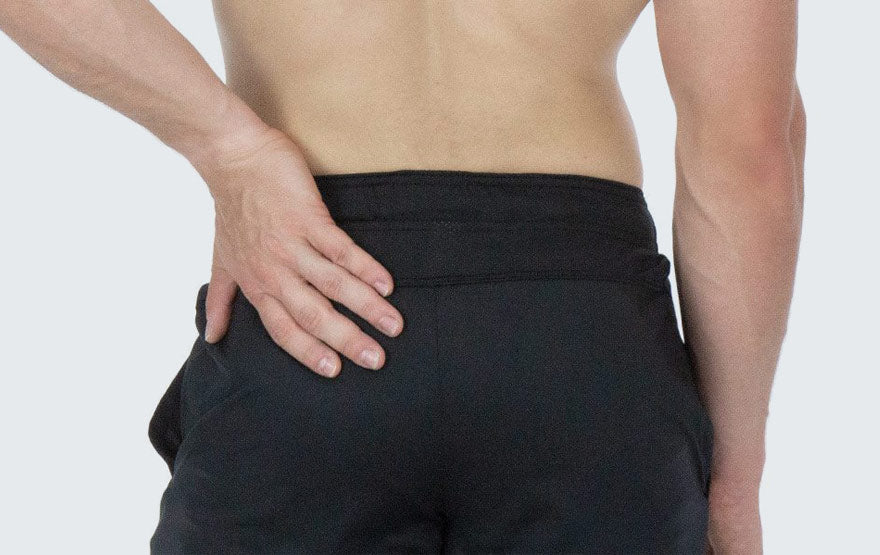Your Cart is Empty
Injury

SI joint pain is a very ambiguous issue that can make it hard to properly diagnose and treat. Luckily, finding the right information early can help you avoid some of the worst symptoms. In this guide, we will explain what causes SI joint pain and how it can be treated and prevented.
The sacroiliac (SI) joints are located where the iliac bones and the sacrum meet. The left and right iliac bones make up the pelvis, and the sacrum is the triangular-shaped bone in the lower part of the spine. On many people, you can eyeball where the SI two joints are located by the dimples in the low back just above the buttock
The SI joints absorb shock, support the weight of the upper body, and reduce pressure on the spine. Their ultimate job is to streamline weight transfers between the upper body and legs with everyday movements. When pushed to their limits or chronically imbalanced, SI joints can become inflamed and cause lower back or upper leg pain. In fact, about 30% of chronic lower back pain cases are caused by SI joint dysfunction. Chronic and acute SI joint pain result from injury or damage to the ligaments, surrounding muscles, cartilage, or the joint itself.
SI joint pain and other forms of low back pain can be hard to differentiate. It requires close attention to symptoms and what specific activities aggravate it. This is why a trusted medical professional will do an in-depth history and physical exam.
Typically, the source of the dull or sharp SI joint pain can be traced to either:
When there is no movement at the SI joint it can lead to dysfunction due to poor weight transfer in the lower body and putting extra strain on the SI joint itself. This can also cause pain issues “down the chain” of the lower body, such as the knee, foot, or ankle.
Too much movement can alter the normal joint motion and the ability to accept weight through the pelvis. This can lead to hip or lower back pain and may radiate into the groin area due to poor core stability.
Understanding how to relieve SI joint pain begins by understanding its major causes. Several conditions can cause SI joint pain, including:
Direct trauma or severe impact can damage or strain your SI joints. An injury due to a bad fall or a car crash is one of the most common causes of SI joint pain.
Uneven strides when walking can also lead to SI joint pain. For example, if one leg is shorter than the other or you limp, too much stress is placed on the SI joint.
Imbalanced weight through the pelvis, such as standing or leaning to one side, or lying in a crooked position can put unnecessary strain on the entire pelvis system.
If your body has high levels of uric acid, the risk of developing gout is high. Even though gout usually affects the large toe first, joints such as the SI joint may also be affected.
Excessive or prolonged stress on the SI joint can gradually damage the protective cartilage and result in osteoarthritis. This common joint disease may also affect the spine and other joints throughout the body.
This type of inflammatory arthritis, which seriously affects the joints and vertebrae of the spine, can often lead to SI joint pain. Apart from chronic pain and discomfort in the lower back, severe cases of ankylosing spondylitis may cause inflammation in other joints and, rarely, in eyes and organs.
It is important to pay attention to the symptoms you are experiencing, as SI joint pain is easily confused with other health problems that affect the lower back. Common symptoms of an SI joint injury include:
Diagnosing SI joint back pain can be complicated, as its symptoms mimic other lumbar spine conditions such as radiculopathy and disc herniation. Oftentimes, damage to the joints does not show up on imaging tests (and is not typically recommended for diagnosis). Your doctor may conduct the following steps to accurately diagnose your SI joint pain.
During the physical exam, your doctor will manipulate the joints or feel for tenderness to confirm whether SI joint back pain is the cause of your discomfort. Give your doctor details regarding the level of your functionality and the exact location of your pain.
MRI scans, CT scans, and X-rays can help rule out other potential causes of pain if needed. Your doctor will consider key factors that may be causing or exacerbating your symptoms to determine whether another health condition is contributing to SI joint issues.
Injecting the SI joint with pain medicine can be a useful diagnostic test. This procedure is known as a sacroiliac joint block. To ensure the needle is inserted correctly, your doctor will use either CT guidance or fluoroscopic guidance. If there is inflammation in the SI joint, groin pain and lower back pain will decrease after the injection.
SI joint healing may be a quick process if it's caused by trauma or injury. However, when the causes are related to chronic conditions, such as osteoarthritis and ankylosing spondylitis, it will take more time and diligence to get results.
Walking for at least twenty minutes, about twice a week, is a great way to care for your lower back. Wear comfortable shoes and focus on taking small comfortable and balanced strides. When you no longer feel pain, progress to a 30-minute walk every day.
There is no overnight fix for SI joint dysfunction. To completely recover from SI joint pain, physical therapy and other at-home remedies should be followed consistently. Controlled, gradual physical therapy can improve flow of blood to the area, increase range of motion, and strengthen the muscles around the SI joint, which in turn may stimulate a healing response.
Find Exercises Safe for SI Joint Pain
SI joint pain should not run your life. Talk to your doctor about the best ways to heal and manage your symptoms. Combine awareness and patience with the right treatments to return to the activities you love. As the pain and inflammation decrease, focus on restoring your sacroiliac joint’s normal function with muscle strengthening and endurance training of the core. This will help promote normal pelvic alignment and balance.
SHOP SI JOINT PAIN PRODUCTS
![The Benefits of Flexibility [A.K.A. The Secret Sauce for Aging]](http://www.vivehealth.com/cdn/shop/articles/Smiling-retired-woman-listening-to-music-while-stretching-legs-outdoors._600x.jpg?v=1713090677)

